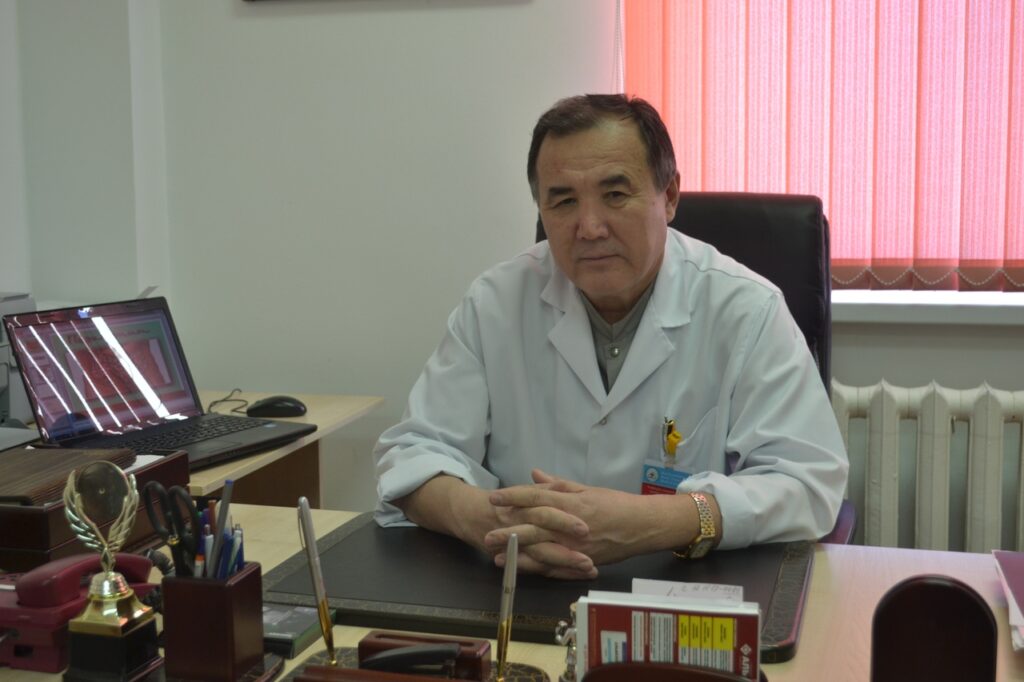Bazylbek ZHAKIEV: We want to achieve a reduction in the number of amputations

One of the intra-university scientific and technical projects of our university is called “Optimization of surgical interventions in the complex treatment of neuroischemic and ischemic forms of diabetic foot syndrome.”The head of the Department of Surgical Diseases No. 2, Doctor of Medical Sciences, Professor Bazylbek Zhakiev, spoke about the severity of the disease, methods of surgical treatment and the clinical significance of the work.

– Bazylbek Sagidollaevich, what is the scientific and practical interest of diabetic foot syndrome from the point of view of surgery?– First of all, I want to say that diabetes mellitus is the most common endocrine disease in the world, approximately 4-5 percent of the world’s population suffer from this disease. And every year there is a tendency to an increase in the number of patients. According to the WHO, in 1995, 120 million people in the world suffered from diabetes mellitus, and in 2010 there were already 220 million such people. And in five years, the growth of diabetics is predicted to reach 380 million!Of the total number of patients, 30-80 percent develop the so-called “diabetic foot”, or diabetic foot syndrome. Perhaps the question arises, why are we, surgeons, dealing with this problem? After all, this is an endocrine disease, which means that endocrinologists should deal with it. In 1987, the World Health Organization identified the diabetic foot as an independent complication of diabetes mellitus, along with diabetic damage to the eyes, kidneys, nervous and cardiovascular systems. Pathology means an infection, ulcer or destruction of foot tissues associated with neurological disorders and a decrease in the main blood flow in the arteries of the lower extremities. Therefore, diabetic foot syndrome is the most dramatic complication of diabetes mellitus, since in half of the cases it ends with amputation and leads to disability, causing significant socio-economic damage.The development of limb gangrene is an indication for amputation, which is the most common surgical operation for diabetic foot, and is most often performed at the hip level, immediately after which the mortality rate reaches 25%. At the same time, within five years after the operation, the likelihood of the development of corresponding changes in the other limb increases, accompanied by mortality reaching 40-60%. According to European authors, the ratio of the number of amputations to the number of diabetic patients ranges from 5.7 to 20.5 per 100 thousand of the total population. Back in 1989, an international declaration on the complications of diabetes was adopted in the Italian city of Saint Vincent. One of the main tasks outlined by the declaration is to reduce the number of amputations in patients with diabetes mellitus by 50%. This would be considered an excellent result. But, unfortunately, so far this has not been possible. In addition, among those operated on after a high amputation of a limb in the next 5 years, no more than 25-40% of patients survive. In our country, about 180,000 people suffer from diabetic foot syndrome – this is the population of an entire city. And, imagine if half of them have to amputate their lower limb. These are terrible statistics. Therefore, over the past 20 years, the attitude towards amputations in diabetic foot syndrome has changed towards the maximum possible preservation of the limb, which is the main task of treatment in this pathology. However, the treatment of diabetic foot syndrome in most cases remains long, laborious and costly.Based on the principles of the pathogenesis of diabetic foot syndrome, the success of treatment is impossible without improving blood circulation and eliminating hemodynamic disorders in the affected limb.There are many methods of treating diabetic foot, which indicates their low and insufficient effectiveness, and sometimes the absence of the latter. Therefore, increasing the effectiveness of treatment of diabetic foot syndrome is an urgent and socially significant medical problem.

– Did you have experience of research and work in this direction before?– On the basis of the department, since 1990, the only Republican Center for the problems of urgent surgery and peritonitis has been functioning in the country, so we are actively engaged in these problems to this day. But when our department in 2014 was transferred from the emergency hospital to the Aktobe Medical Center (AMC), we saw that this clinic is the only medical institution where patients with diabetic foot syndrome are admitted. The most common surgical procedure for diabetic foot was amputation of a limb at the hip level. Therefore, I turned to my colleagues – let’s do something! Moreover, we had some experience in the surgical treatment of patients with diabetic foot syndrome. Previously, for almost six years, from 2003 to 2009, he headed the Department of Faculty Surgery, which was based in the surgical department of the Medical Center of the Marat Ospanov West Kazakhstan State Medical University. Then patients with diabetes mellitus complicated by sin were also admitted to the surgical department.– Who is on your team working on this topic?– In 1991 in the Netherlands, at the I International Symposium on the Diabetic Foot, a classification of the diabetic foot syndrome was proposed. Distinguish between neuropathic, ischemic and mixed – neuroischemic forms of diabetic foot. Most often, in 40-45% of cases, there is a neuroischemic form, in 10-15% of cases – ischemic. This means that our task is to improve blood supply, oxygenation, macro- and microcirculation of the affected limb.The development of endovascular technologies with the use of antegrade and retrograde approaches helps to reduce the number of shunting operations on the vessels, which are longer and more difficult for the patient. Due to safety, low mortality and cost-effectiveness, endovascular interventions on the arteries of the lower extremities in patients with obliterating vascular diseases are widely used for the treatment of critical ischemia of the lower extremities. Therefore, we decided to apply minimally invasive revascularizing operations – endovascular balloon angioplasty or stenting of the peripheral arteries of the lower extremities in the complex treatment of diabetic foot syndrome. Approximately 20% of patients have “multi-storey” lesions of the arterial bed of the lower extremities with diabetic foot syndrome. This requires appropriate reconstructions, which, when using traditional bypass surgery, is associated with an increased volume of surgery and its trauma. In such cases, it becomes necessary to use “hybrid” operations – reconstructive interventions on the great vessels with endovascular balloon angioplasty or stenting of the peripheral arteries of the lower extremities. Therefore, we attracted specialists from practical health care who are directly related to this problem. This is Ph.D. Mukanov Samat Maksatovich, who works in the emergency hospital of Aktobe, and previously worked in the NSCH named after A.N. Syzganov in interventional surgery, and Zhanabaev Bernat Kazmukhanovich, head of the vascular department of the AMC. They have been dealing with this problem since 2015, and, I must say, the results are very good. And when an intra-university project on our current topic was announced, we, having set ourselves the goal of reducing the frequency of amputations at least slightly, included them in our work. In addition to them, our group includes the head of the department of general surgery of our university, Dr. med. Dzhakanov Murat Kenestikovich, Candidate of Medical Sciences, Associate Professor Mukushev Manas Maksatovich, Candidate of Medical Sciences Koishybaev Anuar Sultanovich, master Aitbaeva Aliya Matzhanovna.– The project is not over yet. But can you already draw any conclusions?– Now we have begun to study the results of our work. Earlier, as I said, we worked on this topic, and the main goal was to preserve the ability to support, that is, so that a person could stand on his own two feet. Because after amputation, the quality of life is noticeably reduced. As the preliminary results of our research show, after the use of minimally invasive endovascular interventions, in the complex treatment of diabetic foot syndrome, there is a significant positive dynamics of rheohemodynamic parameters, the course of the wound process improves, the time for cleansing purulent-necrotic wounds decreases, the frequency of amputations of the lower extremities decreases, and the support ability of the foot is preserved in 94 , 4% of patients. At the same time, one cannot do without amputation at all. But this is called necrectomy, when the toes or half of the foot can be removed, but the person’s ability to lean on the leg remains, and he can walk on his own, even with the help of orthopedic shoes.

– What is your goal based on the results of all your work?– The project, which started in 2019, was designed for three years. This year we are completing the project and have received good, even encouraging results. At the end of our scientific and technical project, we want to determine the indications and contraindications for the use of endovascular and hybrid operations in the complex treatment of diabetic foot syndrome, to determine the criteria for choosing the above operations in terms of the greatest safety and efficiency, and also to develop an algorithm for the complex treatment of diabetic foot syndrome, including the optimal a combination of conservative methods and surgical interventions, taking into account the selection criteria.Thus, to date, the problem of treating patients with diabetic foot syndrome is still far from being solved and requires further research to develop general principles of complex treatment.



 Marat Ospanov West Kazakhstan Medical University
Marat Ospanov West Kazakhstan Medical University




